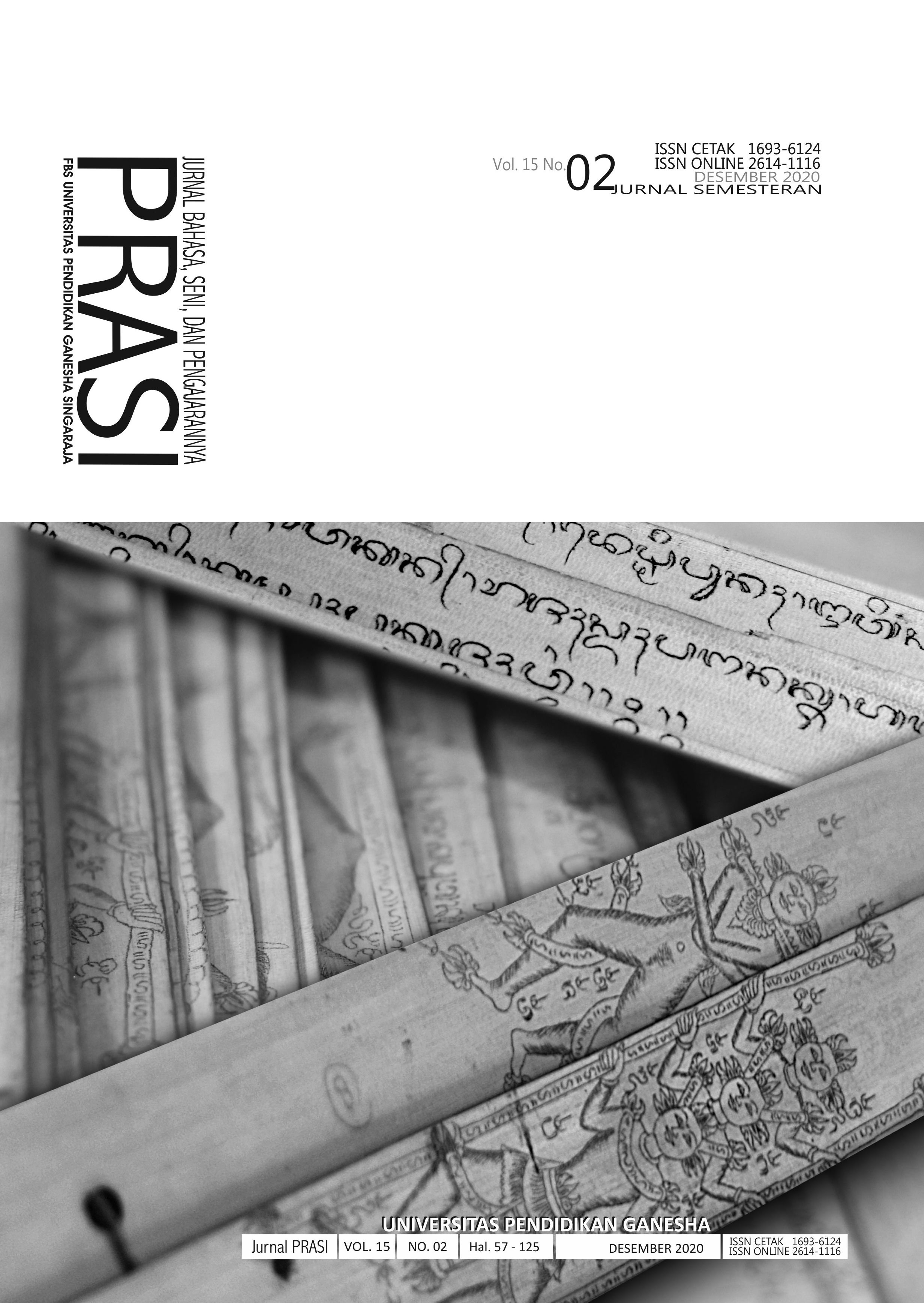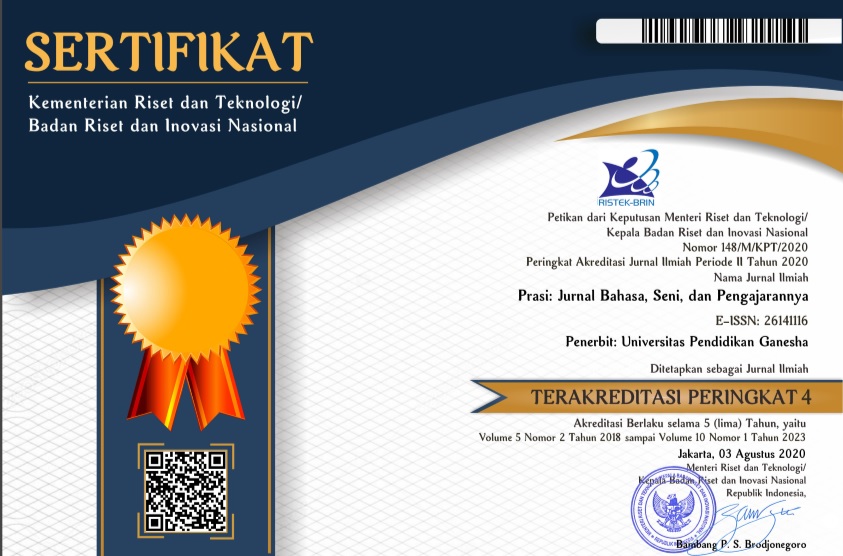THE QUALITY OF TEACHER-MADE MULTIPLE-CHOICE TEST USED AS SUMMATIVE ASSESSMENT FOR ENGLISH SUBJECT
DOI:
https://doi.org/10.23887/prasi.v15i02.25560Keywords:
instrument quality, norms, teacher-made multiple-choice testAbstract
This study analyzed the quality of multiple-choice test used as middle test made by the English teachers in one school in Singaraja. This study was essential to be conducted since the items of the multiple-choice test must have good quality to be used to assess the students’ achievement levels. This study used content analysis method in analyzing100 items from 3 different instruments. In collecting the data, the checklist analysis form was used to compare the items of teacher-made multiple-choice test with the norms as one of the standards in making a good multiple-choice test, then clarified through interview. From the data that have been obtained, there are 72% of students who got bad scores in the middle test. There is 1% of the items has sufficient quality, 8% of items have good quality, and the rest of the items have very good quality. The most common mistake found is in the punctuation and capitalization. It is supported by the results of the interview, which show that the teachers did not know precisely the norm of punctuation and capitalization. It can be concluded that the teachers already follow the norms of making a multiple-choice test, and it is indicated that the quality of the multiple-choice test is not the only factor that affects students’ achievement levels.
Keywords: instrument quality, norms, teacher-made multiple-choice test
References
REFERENCES
Allen, R.E. (2002). Punctuation. Oxford: Oxford University Press.
Arabsarhangi, M. & Noroozi, I. (2014). The relationship between self-awareness and learners’ performance on different reading comprehension test types among Iranian EFL elementary learners. Theory and Practce in Language Studies, 4(4), 675-685.
Ary,D., Jacobs, L.C., Sorensen, C, & Razavieh. (2010). Introduction to research in education. Canada: Wadsworth, Cengage Learning.
Burton, S. J., Sudweeks, R. R., Marrill, P.F., & Wood, B. (1991). How to prepare better multiple-choice test items: Guidelines for university faculty. Brigham Young University Testing Services and The Department of Instructional Science.
Connelly, M. (2009). Get writing: Sentences and paragraph. Cengage Learning.
Crockett, L.W. & Churches, A. (2016). Mindful assessment. Indiana: Solution Tree Press.
Dehnad, A., Nasser, H., & Hosseini, A. F. (2014). A comparison between three-and four-option multiple-choice questions. Procedia Social and Behavioral Sciences, 98, 398-403.
Ebel, R. L. (1951). Writing the test item: In E.F. Linguist (Ed), educational measurement. Washington, DC: American Council on Education.
Effendi, T. & Suyudi, I. (2017). The impact of English national examination in Indonesia. Advances in Social, Science, Education, and Humanities Research. 82. Retrieved 2nd of September 2019 from http://creativecommons.org.
Flavian, Heidi. (2016). Towards teaching and beyond: Strengthening education by understanding students’ self-awareness development. Power and Education, 8(1),88-100.
Haladyna, T.M. (2004). Developing and validating multiple-choice test items. New Jersey, London: Lawrence Erlbaum Associates.
Hall, C. & Marshall, S. (2013). A guide for developing multiple-choice and other objective style questions. New Zealand: Centre for Academic Development.
Hanna, G. S. & Dettmer, P.A. (2004). Assessment for effective teaching: Using context-adaptive planning. Boston, MA: Pearson A & B.
Iliya, A. & Ifeoma, L.G. (2015). Assessment of teacher motivation approaches in less developed countries. Journal of Education and Practice, 6(22),10-17.
Ingale, A.S., Giri, P.A., & Doibale, M.K. (2017). Study on the item and test analysis of multiple-choice questions amongst undergraduate medical students. International Journal of Community Medicine and Public Health, 4(5), 1562-1565.
Lebagi, D., Sumardi, & Sudjoko. (2017). The quality of the teacher-made test in EFL classroom at the elementary school and its Washback in the learning. Journal of English Education. 2(2). 97-104.
Mappiasse, S. S. & Sihes, A.J.B. (2014). Evaluation of English as a foreign language and its curriculum in Indonesia: A review. English Language Teaching, 7(10).113-122.
Martinez, J. F., Steche, B., & Borko, H. (2009). Classroom assessment practice, teacher judgments, and student achievement in mathematics: Evidence from the ECLS.Educational Assessment. 14.78-102.
Mukherjee, P. & Lahiri, S. K. (2015). Analysis of multiple-choice questions (MCQs) : Item and test statistics from an assessment in a medical college of Kolkata, West Bengal. IQSR Journal of Dental and Medical Sciences,14(12), 47-52.
Nurkencana, W. & Sunartana. (1992). Evaluasi hasil belajar. Surabaya: Usaha Nasional.
Omoruan, B. E. (2018). Valid teacher-made tests: It’s implication on students’ achievement in business education. ATBU, Journal of Science, Technology & Education (JOSTE). 6(2).
Patil, R., Palve, S. B., Vell, K., & Boratne, A. V. (2016). Evaluation of multiple-choice questions by item analysis in a medical college at Pondicherry , India. International Journal of Community Medicine and Public Health, 3(6), 1612–1616.
PerMendikbud. (2016). Peraturan Menteri Pendidikan dan Kebudayaan nomor 23 tahun 2016.
Pintrich, P.R. & Date, H.S. (2008). Motivation in education theory, research and application. New Jersey: Pearson Education.
Reece, I. & Walker, S. (1997). Teaching, training and learning: A practical guide. Sunderland: Business Education Publisher.
Richard, J.C. & Renandya, W.A. (2002). Methodology in language teaching: An anthology of current practice. Cambridge: Cambridge University Press.
Rinkeviciene, I. & Zdanyte, J. (2002). Raising students’ awareness in language learning. Kalbu Studios, 3.
Roy, Goutam. (2016). Competency-based assessment in primary education in Bangladesh- A review. Bangladesh: Share TA Office.
Santrock, J. W. (2004). Psikologi Pendidikan. Jakarta: Kencana Prenada Media Group.
Tastan, S.B., Davoudi, S.M.M., Masalimova, A.R., Bersanov, A.S., Kurbanov, R.A., Boiarchuk, A.V., & Pavlushin, A.A. (2018). The impacts of teacher’s efficacy and motivation on student’s academic achievement in science education among secondary and high school students. EURASIA Journal of Mathematics, Science and Technology Education, 4(6),2353-2366.
Ur, Penny. (1996). A course in language teaching: Practice and theory. Cambridge: Cambridge University Press.
Zimmaro, D. M. (2016). Writing good multiple-choice exams. Austin: University of Texas.
Downloads
Published
Issue
Section
License
Authors who publish with Prasi agree to the following terms:- Authors retain copyright and grant the journal the right of first publication with the work simultaneously licensed under a Creative Commons Attribution License (CC BY-SA 4.0) that allows others to share the work with an acknowledgment of the work's authorship and initial publication in this journal
- Authors are able to enter into separate, additional contractual arrangements for the non-exclusive distribution of the journal's published version of the work (e.g., post it to an institutional repository or publish it in a book), with an acknowledgment of its initial publication in this journal.
- Authors are permitted and encouraged to post their work online (e.g., in institutional repositories or on their website) prior to and during the submission process, as it can lead to productive exchanges, as well as earlier and greater citation of published work. (See The Effect of Open Access)


.png)
.png)









